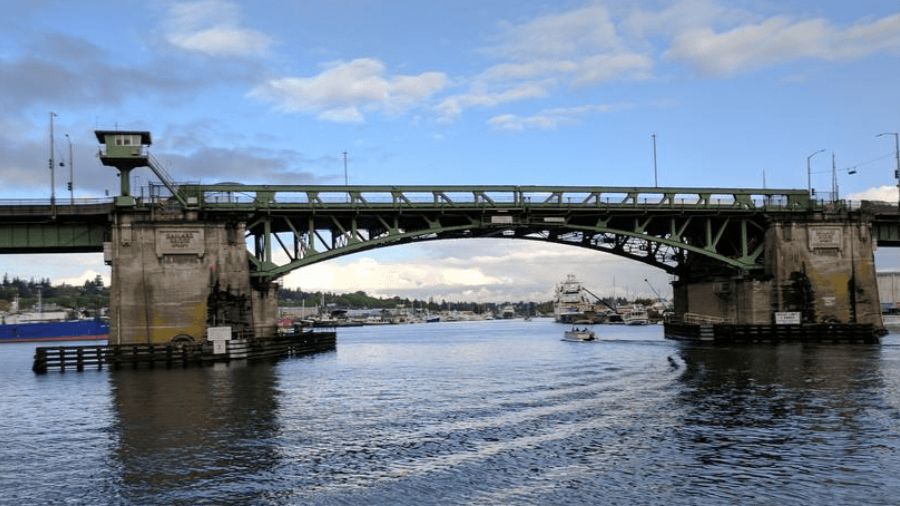Chokepoints: Answers to listener’s FAQs regarding I-5’s express lanes
Jan 23, 2024, 10:22 AM | Updated: Jan 24, 2024, 11:27 am

Photo courtesy of 成人X站 7
I continually get questions about the Interstate 5 (I-5) express lanes. Everything from their operations to graffiti, so I decided to answer the most common ones.
First, a little history lesson.
The express lanes were built in the 1960s when traffic modeling showed that I-5 had much more demand coming to and from north of Seattle. They were built to help those commuters have a faster and more reliable route in and out of downtown, without having to worry about merging traffic.
It was not built as a bypass of downtown Seattle.
More from Seattle: The weather’s big warm-up will stick
The most common question I get about the is why they aren’t automated. Why are several Washington Department of Transportation (WSDOT) employees needed at the gates when the lanes switch from northbound to southbound or in reverse?
WSDOT’s Michael Forbis is the engineering manager of the Traffic Management Center, located in Shoreline. He said the lanes were automated when they first opened.
“Due to some safety concerns, the department stopped up the automated operation of the of the express lanes, and that happened really early on in the late ’60s,” Forbis said.
What was the safety concern? It was a driver trying to beat the closing gates.
“What was finally determined is they really needed an on-site operator, somebody that was right at the button with the gate that could determine if that vehicle was going to run or not,” Forbis said.
Those WSDOT workers are there to make sure no one runs the gates. They also put up the safety netting by hand. Forbis said the system is operated by remote control and is technically automated. The employees are there to ensure safety.
The second most common question is why the lanes aren’t operated 24 hours a day. That’s how they started. The lanes were open all hours until the 1990s when people living near the Ship Canal Bridge upped their noise complaints.
“Because of that configuration and the geometry of the bridge, the noise from the express lanes bounces off the upper deck and bounces into the neighborhoods basically the East Lake neighborhoods,” Forbis said. “Ever since I-5 was built, the Eastlake communities complained about the noise.”
WSDOT looked for ways to dampen that noise but ultimately decided to close the lanes at night.
“What they asked us to do was to close the Express Lanes at night so we did traffic analysis and looked whether we really needed to use the express lanes at night, and the answer to that was no,” Forbis said.
If the traffic analysis were to change, WSDOT would reconsider the hours of operation.
It’s the overnight hours that lead to the next question, which is about graffiti.
Some listeners believe that leaving those lanes dark and quiet gives taggers too much access to their canvas. WSDOT’s James Poling said taggers would still be active, even if the express lanes were open all hours.
“They’re out there tagging inches away from cars zooming by and that would be a very similar situation if the express lanes are open at night,” he said. “They’re just taking risks where it really doesn’t matter at this point there’s traffic or not.”
WSDOT spends hundreds of thousands of dollars each year to repaint and remove the graffiti, but the taggers come right back.
The tunnel sections of the express lanes, which have tiles, requiring special paint too.
“It’s really a challenge, especially in express lanes, because of that specialized paint to have the graffiti removed in a timely matter,” Poling said.
And WSDOT workers at the TMC in Shoreline report every tagger they see.
More from Chokepoints: Reducing traffic fatalities one ‘stroad’ at a time
“If we see somebody out there and we do see people paint, it’s an immediate call State Patrol,” Forbis said.
成人X站 Newsradio morning host Dave Ross has been pitching his anti-graffiti to me for months. He believes installing fake ivy over all of the walls would do the trick. I ran that by Forbis.
“That’s one I have not heard of heard,” Forbis chuckled. “I’ve heard of lot about graffiti-proof paint, but I haven’t heard of fake ivy.”
He has now. WSDOT continues to look at the lanes and how they can be improved. A big change is coming to them later this year when the reversible lane into them from SR 520 opens.
Check out more of Chris’ Chokepoints here. You can also follow Chris on . to follow 成人X站 Newsradio Traffic’s profile .












